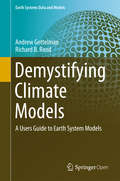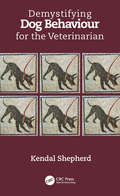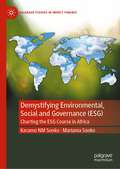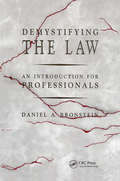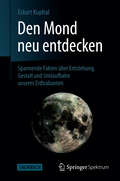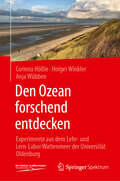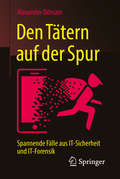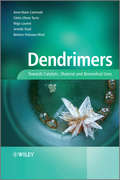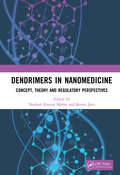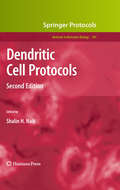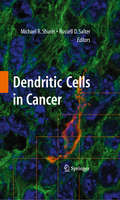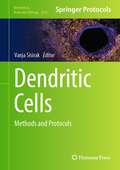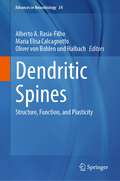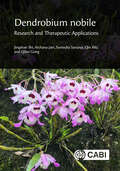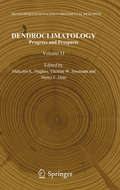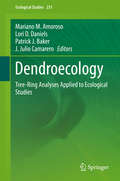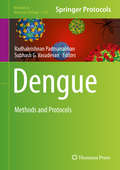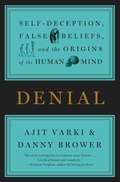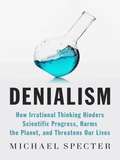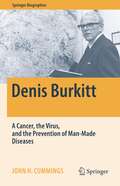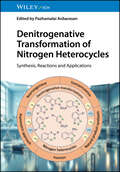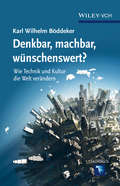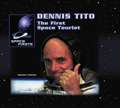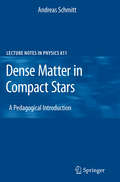- Table View
- List View
Demystifying Climate Models: A Users Guide to Earth System Models (Earth Systems Data and Models #2)
by Andrew Gettelman Richard B. RoodThis book demystifies the models we use to simulate present and future climates, allowing readers to better understand how to use climate model results. In order to predict the future trajectory of the Earth’s climate, climate-system simulation models are necessary. When and how do we trust climate model predictions? The book offers a framework for answering this question. It provides readers with a basic primer on climate and climate change, and offers non-technical explanations for how climate models are constructed, why they are uncertain, and what level of confidence we should place in them. It presents current results and the key uncertainties concerning them. Uncertainty is not a weakness but understanding uncertainty is a strength and a key part of using any model, including climate models. Case studies of how climate model output has been used and how it might be used in the future are provided. The ultimate goal of this book is to promote a better understanding of the structure and uncertainties of climate models among users, including scientists, engineers and policymakers.
Demystifying Dog Behaviour for the Veterinarian
by Kendal ShepherdThe behaviour textbook that's been missing! - Dr Mandy Roshier, University of Nottingham, School of Veterinary Medicine and Science, UK This practical guide for busy veterinarians demystifies the apparently complex nature of canine behaviour while simultaneously emphasising its importance. Authored by acclaimed veterinary behaviour consultant Kendal Shepherd, the book provides practical knowledge of dog behaviour and an understanding of how to talk about it with clients. Shepherd shows how this can enhance the relationship between owner and pet and between dog and environment, including the vet surgery, as well as improve the vet’s own sense of fulfilment and enjoyment of practice. From a discussion on the true nature of obedience to stressing the importance of behavioural indicators when assessing pain and mental welfare and finally by reminding vets of their obligations under Dangerous Dogs legislation, the emphasis is on the prevention of aggression throughout. Packed with anecdotes drawn from real-life cases, easy to read and understand, the principles explained can be effortlessly assimilated into the average consultation without the need for lengthy report-writing.
Demystifying Environmental, Social and Governance: Charting the ESG Course in Africa (Palgrave Studies in Impact Finance)
by Karamo NM Sonko Mariama SonkoAddressing a topic at the forefront of global interests in business and development, this book is the first comprehensive book in the world that addresses ESG wholistically. It combines academic and practical content through multidisciplinary analysis, integrating economics, statistics, finance, strategic management and mathematics with an African focus. The book argues that ESG is largely in the interest of the firms/companies themselves, in addition to benefitting the larger society in which they exist. It also makes it everyone's responsibility to play a part in addressing global climate challenges. Thus, the book views the survival of the corporations, economies and the larger societies as interlinked. It will be of interest to researchers, policymakers and business persons in and outside of Africa.
Demystifying the Law: An Introduction for Professionals
by Daniel A. BronsteinDemystifying the Law: An Introduction for Professionals explains unfamiliar legal concepts in interesting contexts, thus helping you to understand and remember them. It illustrates legal principles using simple examples that anyone can understand. No single book can turn you into a lawyer, but this one can help you decide when you need a lawyer's assistance and help you ask intelligent questions of your lawyer. It can even help keep you out of situations requiring a lawyer. Part I tells you where our laws come from and how they are applied in the court system. Part II explains the role in law of the executive branch of government, including quasi-legislative and quasi-judicial activities, judicial review, and technicalities and terms. Part III covers several specific legal issues, including civil procedure, criminal law concepts, burden of proof, the "reasonable person" concept, breach of duty, personal and product liability, and malpractice. It also gives brief introductions to contracts, insurance law, workers' compensation, property law, environmental law, water law, and other legal matters. Every professional should own this valuable resource! Ideal for both personal and business use. Appendices include how to find legal citations and extracts from the federal rules of civil procedure.
Den Mond neu entdecken: Spannende Fakten über Entstehung, Gestalt und Umlaufbahn unseres Erdtrabanten
by Eckart KuphalUnser Mond ist uns vertraut - und birgt zugleich viele Geheimnisse, die wir mit Hilfe der Naturwissenschaften lüften können. Dieses Sachbuch über den Mond und seine Bewegung wendet sich an naturwissenschaftlich interessierte Leser aller Altersstufen, die den Mond noch einmal neu entdecken möchten. Der Text enthält stellenweise auch Formeln und Berechnungen, die aber nicht über die physikalisch-mathematischen Anforderungen einer gymnasialen Oberstufe hinausgehen. An den Anfang ist die Geschichte der Mondbeobachtung gestellt, die einen Bogen spannt von der Antike über die Erfindung des Fernrohrs in der Neuzeit bis hin zur Raumfahrt und bemannten Mondlandung. Auch die gegenwärtig den Mond umkreisenden Raumsonden werden beschrieben. Daneben werden die Besonderheiten des Erdmonds innerhalb des Sonnensystems aufgezeigt und die Voraussetzungen für Leben auf anderen Planeten und Monden beschrieben. Auch der Einfluss des Mondes auf das irdische Leben wird betrachtet. Ein weiterer Schwerpunkt des Buches ist die Darstellung der Ellipsenbahn des Mondes um die Erde und um die Sonne. Dazu gehören seine verschiedenen Beleuchtungsphasen und sein scheinbares 'Kopfnicken' und 'Kopfschütteln', das wir von der Erde aus sehen und wissenschaftlich leicht verstehen können. Mit Hilfe von Grafiken wird der Weg des Mondes über dem irdischen Horizont erläutert und Ebbe und Flut als Folge der Gezeitenkräfte des Mondes und der Sonne beschrieben. Nicht zuletzt erfährt der Leser, wie man Sonnen- und Mondfinsternisse einfach vorausberechnen kann. Zum Schluss wird dargestellt, warum der Mond sich so seltsam unregelmäßig bewegt. Ein Buch für alt und jung - für Anhänger und Fans unseres Mondes und solche, die es werden wollen. Eckart Kuphal, geboren in Berlin, ist promovierter Physiker (Inst. Kernphysik der TU Darmstadt) und war seit 1975 langjähriger Leiter der Arbeitsgruppe "Epitaxie von Halbleiterstrukturen" am Forschungsinst. der Dt. Telekom in Darmstadt. Er ist Autor von mehr als 100 wiss. Publikationen auf den Gebieten Kernphysik und Halbleitertechnologie. Seit über zehn Jahren befasst er sich mit Astronomie und hält darüber Vorträge.
Den Ozean forschend entdecken: Experimente aus dem Lehr- und Lern-Labor Wattenmeer der Universität Oldenburg
by Corinna Hößle Holger Winkler Anja WübbenDer Ozean ist die Grundlage alles Lebendigen auf dieser Erde und stellt uns eine Vielzahl an Ressourcen zur Verfügung. Und doch ist dieses System massiv gefährdet durch die anthropogene Nutzung. In diesem Lehrwerk erfahren Sie anhand einfacher Experimente und gut strukturierter Anleitungen wichtige chemische, physikalische und biologische Hintergründe zum komplexen und empfindlichen System des Ozeans. Erstmals werden die mehrfach erprobten und optimierten Experimente eines Schülerlabors veröffentlicht, basierend auf langjähriger Zusammenarbeit von Meereswissenschaftler*innen und Fachdidaktiker*innen. Das Lehr- und Lernlabor Wattenmeer der Universität Oldenburg stellt hiermit allen Interessierten ihr fächerübergreifendes und fachdidaktisch reflektiertes Experimentierangebot zur Verfügung. Zusätzlich erhalten Sie Materialien zur Förderung des verantwortungsbewussten Urteilens und Handelns in Bezug auf die Ozeannutzung. Diese ermöglichen eine einfache Integration in den Unterricht und entfachen spannende Diskussionen. Sie werden in eine Methode eingeführt, die eine ethische Bewertung anthropogener Nutzungsweisen des Ozeans ermöglicht und dabei ökologische, soziale und ökonomische Aspekte berücksichtigt. Dabei werden Methoden zur Wertanalyse, Argumentationsweise und Folgenanalyse sowie zum Perspektivwechsel vorgestellt, die eine direkte praktische Umsetzung in unterschiedlichen Bildungseinrichtungen ermöglichen. Das Buch greift damit die Ziele der Bildung für eine nachhaltige Entwicklung konkret auf und bietet Ihnen viele wertvolle und sehr gut ausgearbeitete Möglichkeiten, diese am Beispiel des Themas Ozean in Ihrem Bildungsbereich handlungsorientiert umzusetzen. Nutzen Sie dieses umfassende Angebot, um relevante Themen in Ihrem Lehrplan zu integrieren.
Den Tätern auf der Spur
by Alexander DörsamAus dem Alltag eines digitalen Ersthelfers Der IT-Sicherheitsexperte Alexander Dörsam entführt Sie mit seinem Buch in die spannende Welt von Hacking, Unternehmenserpressung, Spionage und digitalem Vandalismus. Anhand von realen IT-Sicherheitsvorfällen erfahren Sie, wie Angreifer in Firmenstrukturen eindringen, welche Methoden dafür eingesetzt werden und welche Folgen das haben kann. Doch wie schütze ich mich oder mein Unternehmen? Was ist zu tun bei einem digitalen Notfall? Dörsam hilft Ihnen nicht selbst Opfer zu werden, zeigt das IT-Krisenmanagement und gibt Hinweise zur Ersthilfe bei IT-Sicherheitsvorfällen. Ein fesselndes Buch für alle, die mehr über aktuelle digitale Bedrohungen erfahren wollen.
Dendrimers
by Anne-Marie Caminade Beatrice Delavaux-Nicot Cedric-Olivier Turrin Regis Laurent Armelle OualiThis book will be mainly focussed on the properties and uses of dendrimers and dendrons. The aim of this book is to be the reference book about dendrimers applications. It will not describe all details, but it will give the reader a unique overview of what has currently been done with dendrimers, with numerous references and illustrations. It will be divided in four main parts: Part 1) Generalities, syntheses, characterizations and properties; Part 2) Applications in catalysis; Part 3) Applications for the elaboration or modification of materials; and Part 4) Applications in biology/medicine. The role of the nanometric size and the multiple functions of dendrimers on the properties will be emphasized.
Dendrimers in Nanomedicine: Concept, Theory and Regulatory Perspectives
by Neelesh Kumar Mehra Keerti JainDendrimers, hyperbranched macromolecules, emerged just few decades ago but show promising potential as drug delivery nanocarriers, theranostic agents and gene vectors; in the pharmaceutical research and innovation area as well as in other healthcare applications. Although tremendous advancements have been made in dendrimer chemistry and their applications since their emergence, the synthesis, development and design of pure and safe dendrimer-based products have been a major challenge in this area. This book, edited by well-known researchers in the area of nanomaterials and drug-based drug delivery applications, exhaustively covers the nanotechnological aspects, concepts, properties, characterisation, application, biofate and regulatory aspects of dendrimers. It includes sixteen vivid chapters by renowned formulators, researchers and academicians from all over the world, highlighting their specialised areas of interest in the fields of chemistry, biology, pharmacy and nanomedicine. Features: • Highlights dendrimers’ advancements in nanomedicine in the development of safe healthcare and biotechnological products • Covers physicochemical aspects, biofate, drug delivery aspects and gene therapy using dendrimers • Covers biomedical application of dendrimers in the field of biological sciences • Gives examples of dendrimer–guest interaction chemistry Dendrimers in Nanomedicine: Concept, Theory and Regulatory Perspectives provides the comprehensive overview of the latest research efforts in designing, optimising, development and scale-up of dendrimer-mediated delivery systems. It analyses the key challenges of synthesis, design, molecular modelling, fundamental concepts, drug delivery aspects, analytical tools and biological fate as well as regulatory consideration to the practical use of dendrimer application. Dr. Neelesh Kumar Mehra Assistant Professor of Pharmaceutics in the Department of Pharmaceutics at the National Institute of Pharmaceutical Education & Research (NIPER), Hyderabad, India. He has authored more than sixty peer-reviewed publications in highly reputed international journals, as well as book chapters and contributions on two patents. Dr. Mehra has 11 years of rich research and teaching experience in the formulation and development of complex, innovative biopharmaceutical products including micro- and nanotechnologies for regulated markets. Dr. Keerti Jain Assistant Professor of Pharmaceutics in the Department of Pharmaceutics, NIPER, Raebareli, India. For more than 10 years, she has been actively engaged in formulation and development of nanomedicines. Dr. Jain has supervised masters and doctoral pharmaceutics students in their research works which have been published in high quality, good impact factor journals. She has also authored more than 60 international manuscripts in peer reviewed high impact journals. In 2019, she was awarded the prestigious ICMR-Amir Shakuntala Award.
Dendritic Cell Protocols
by Shalin H. NaikGiven the vital importance of immune system research, the gathering of clear, consistent, and informative protocols involving the study of dendritic cells is paramount. Bringing the popular first edition fully up to date, Dendritic Cell Protocols, Second Edition presents protocols from experts in the field that cover the basics and more complex forays into the exploration of DC development and function, both in mice and humans. The first section of the volume involving humans explores topics such as the isolation of blood DC subtypes, primary skin Langerhans cells, and the generation of gene-manipulated human DCs with the inclusion of more clinically relevant methods as well, while the second section involving rodent models delves into DC and precursor generation in vitro, isolation ex vivo, disease models, as well as DC functions and properties. Written in the highly successful Methods in Molecular BiologyTM series style, chapters include introductions to their respective subjects, lists of the necessary materials and reagents, step-by-step, readily reproducible laboratory protocols, and notes on troubleshooting and avoiding known pitfalls. Comprehensive and cutting-edge, Dendritic Cell Protocols, Second Edition aims to become a bench-side handbook for both beginners and experts in the field of DC research and a long-term reference for some of the most popular methods put forward by those who lead the field.
Dendritic Cells in Cancer
by Russell D. Salter Michael R. ShurinIt covers all aspects of DC generation, function, survival and antitumor activity in the tumor environment both in vivo and in experimental in vitro systems. The goal in focusing on a spectrum of issues related to DC in cancer is to provide an extensive and expansive review rather than a collection of independent analyses from different authors. Specific topics to be covered include analysis of DC behavior in the tumor microenvironment, including endogenous and exogenous DC, multiple DC populations, molecular pathways responsible for DC dysfunction, tumor-derived factors altering DC polarization and activation, mechanisms of DC alterations, and the role of DC in tumor escape from immune recognition and elimination. Furthermore, additional chapters provide extensive analysis of the consequences of cancer therapy on the DC system and how aging impacts DC function in the tumor microenvironment. Finally, chapters are included examining strengths and pitfalls of current methodologies for generating DC from cancer patients for therapeutic purposes and on the role of tumor-mediated modulation of the DC system in cancer immunotherapy.
Dendritic Cells: Biophysics, Biomechanics, Mechanobiology and Tumor Microenvironment
by Zhu ZengThis book focuses on the fascinating topic of tumor microenvironment and dendritic cell immunotherapy. It provides readers with comprehensive insights into this field by offering detailed measurement protocols for assessing the biophysical characteristics of cells, along with bioinformatics analysis and mathematical modeling techniques to explore the initiation of dendritic cell-induced T cell immune responses within the tumor microenvironment. We also delve into the effects of chemical factors, mechanical stimulation, and traditional Chinese medicine on dendritic cells in this specific context. By delving into the intricate interactions between the tumor microenvironment and dendritic cells, readers will gain a profound understanding of tumor progression and the potential of dendritic cells as a therapeutic target. Moreover, the book presents novel perspectives that can pave the way for the development of innovative cancer treatment strategies.
Dendritic Cells: Methods and Protocols (Methods in Molecular Biology #2618)
by Vanja SisirakThis detailed volume provides methods that can be used to study dendritic cell (DC) ontogeny, isolation, migration, and functions. After an introduction to murine and human DC subsets and their unique transcriptional, phenotypic, and functional properties, the book continues with sections covering in vivo studies, in vitro differentiation, enrichment, functional characterization, as well as Omics approaches to study dendritic cells. Written for the highly successful Methods in Molecular Biology series, chapters include introductions to their respective topics, lists of the necessary materials and reagents, step-by-step, readily reproducible laboratory protocols, and tips on troubleshooting and avoiding known pitfalls. Authoritative and practical, Dendritic Cells: Methods and Protocols is an ideal guide to familiarize readers with the current state of the art techniques to investigate these vital cells.
Dendritic Spines: Structure, Function, and Plasticity (Advances in Neurobiology #34)
by Alberto A. Rasia-Filho Maria Elisa Calcagnotto Oliver von Bohlen und HalbachThis reference provides detailed coverage of dendritic spines, the fascinating neuronal components that modulate synaptic transmission, development, strength, and plasticity and are involved in the function of multiple areas of the nervous system. The density, shape, and function of spines may indicate the cellular connectivity and synaptic plasticity in normal and pathological conditions. This field has undergone dramatic advances in terms of techniques and experimental findings from in vitro to in vivo data, from animal models to human neurons, and computational models using artificial intelligence. To address these cutting-edge findings, the book provides state-of-the-art, comprehensive coverage with chapters written by the leading international researchers in the field. The authors consider the multiple implications for the study of dendritic spines with broad implications in the neurosciences and related areas.
Dendrobium nobile: Research and Therapeutic Applications
by Professor Jingshan Shi Dr Archana Jain Dr Surendra Sarsaiya Professor Qin Wu Prof Qihai GongDendrobium nobile, a species of orchid native to South-east Asia, has been revered in traditional medicine systems for centuries due to its medicinal properties and therapeutic benefits. With a rich history in Chinese medicine and other traditional healing practices, there is now much interest in the chemical constituents of this orchid and potential applications for various health conditions. The aim of this book is to bridge the gap between the traditional knowledge surrounding this remarkable plant and the cutting-edge scientific investigations that have shed light on its pharmacological activities. It includes: · An overview of Dendrobium nobile, exploring its historical use in traditional medicine and its significance in various cultures. · Information on the chemical constituents, pharmacological activities, antioxidant properties and potential role in alleviating pain, inflammation, and respiratory diseases. · Therapeutic applications: immune enhancement, management of chronic conditions like diabetes and cardiovascular issues, gastrointestinal disorders, renal diseases, neuroprotection and skin health. · Safety and toxicity issues. · Sustainable practices and conservation of Dendrobium nobile, and the importance of preserving biodiversity.
Dendroclimatology
by Thomas W. Swetnam Malcolm K. Hughes Henry F. DiazA top priority in climate research is obtaining broad-extent and long-term data to support analyses of historical patterns and trends, and for model development and evaluation. Along with directly measured climate data from the present and recent past, it is important to obtain estimates of long past climate variations spanning multiple centuries and millennia. These longer time perspectives are needed for assessing the unusualness of recent climate changes, as well as for providing insight on the range, variation and overall dynamics of the climate system over time spans exceeding available records from instruments, such as rain gauges and thermometers. Tree rings have become increasingly valuable in providing this long-term information because extensive data networks have been developed in temperate and boreal zones of the Earth, and quantitative methods for analyzing these data have advanced. Tree rings are among the most useful paleoclimate information sources available because they provide a high degree of chronological accuracy, high replication, and extensive spatial coverage spanning recent centuries. With the expansion and extension of tree-ring data and analytical capacity new climatic insights from tree rings are being used in a variety of applications, including for interpretation of past changes in ecosystems and human societies. This volume presents an overview of the current state of dendroclimatology, its contributions over the last 30 years, and its future potential. The material included is useful not only to those who generate tree-ring records of past climate-dendroclimatologists, but also to users of their results-climatologists, hydrologists, ecologists and archeologists. 'With the pressing climatic questions of the 21st century demanding a deeper understanding of the climate system and our impact upon it, this thoughtful volume comes at critical moment. It will be of fundamental importance in not only guiding researchers, but in educating scientists and the interested lay person on the both incredible power and potential pitfalls of reconstructing climate using tree-ring analysis.', Glen M. MacDonald, UCLA Institute of the Environment, CA, USA 'This is an up-to-date treatment of all branches of tree-ring science, by the world's experts in the field, reminding us that tree rings are the most important source of proxy data on climate change. Should be read by all budding dendrochronology scientists.', Alan Robock, Rutgers University, NJ, USA
Dendroecology
by Mariano M. Amoroso Lori D. Daniels Patrick J. Baker J. Julio CamareroDendroecologists apply the principles and methods of tree-ring science to address ecological questions and resolve problems related to global environmental change. In this fast-growing field, tree rings are used to investigate forest development and succession, disturbance regimes, ecotone and treeline dynamics and forest decline. This book of global scope highlights state-of-the-science dendroecological contributions to paradigm-shifts in our understanding of ecophysiology, stand dynamics, disturbance interactions, forest decline and ecosystem resilience to global environmental change and is fundamental to better managing our forested ecosystems for the full range of ecosystem goods and services that they provide.
Dengue
by Radhakrishnan Padmanabhan Subhash G. VasudevanInfection by flaviviruses such as dengue virus serotypes (DENV 1-4), Japanese encephalitis virus (JEV), tick-borne encephalitis virus (TBE), yellow fever virus (YFV) and West Nile virus (WNV) impact millions of lives and cause tens of thousands of mortalities each year. Dengue is a global public health emergency especially since there is no preventative vaccine or antiviral treatment for dengue disease. Dengue: Methods and Protocols offers the increasing number of dengue researchers a one-stop protocol book with techniques compiled from the leading laboratories working on dengue. Chapters cover topics such as dengue virus isolation from clinical samples, quantification of human antibodies against the virus, assays to quantify the virus particles, the widely used mouse model to study dengue pathogenesis, vaccine and antiviral efficacies. Written in the successful Methods in Molecular Biology series format, chapters include introductions to their respective topics, lists of the necessary materials and reagents, step-by-step, readily reproducible protocols and notes on troubleshooting and avoiding known pitfalls. Authoritative and easily accessible, Dengue: Methods and Protocols seeks to serve both professionals and novices with its well-honed methodologies on dengue research.
Denial: Self-Deception, False Beliefs, and the Origins of the Human Mind
by Ajit Varki Danny BrowerThe history of science abounds with momentous theories that disrupted conventional wisdom and yet were eventually proven true. Ajit Varki and Danny Brower's "Mind over Reality" theory is poised to be one such idea-a concept that runs counter to commonly-held notions about human evolution but that may hold the key to understanding why humans evolved as we did, leaving all other related species far behind. At a chance meeting in 2005, Brower, a geneticist, posed an unusual idea to Varki that he believed could explain the origins of human uniqueness among the world's species: Why is there no humanlike elephant or humanlike dolphin, despite millions of years of evolutionary opportunity? Why is it that humans alone can understand the minds of others? Haunted by their encounter, Varki tried years later to contact Brower only to discover that he had died unexpectedly. Inspired by an incomplete manuscript Brower left behind, DENIAL presents a radical new theory on the origins of our species. It was not, the authors argue, a biological leap that set humanity apart from other species, but a psychological one: namely, the uniquely human ability to deny reality in the face of inarguable evidence-including the willful ignorance of our own inevitable deaths. The awareness of our own mortality could have caused anxieties that resulted in our avoiding the risks of competing to procreate-an evolutionary dead-end. Humans therefore needed to evolve a mechanism for overcoming this hurdle: the denial of reality. As a consequence of this evolutionary quirk we now deny any aspects of reality that are not to our liking-we smoke cigarettes, eat unhealthy foods, and avoid exercise, knowing these habits are a prescription for an early death. And so what has worked to establish our species could be our undoing if we continue to deny the consequences of unrealistic approaches to everything from personal health to financial risk-taking to climate change. On the other hand reality-denial affords us many valuable attributes, such as optimism, confidence, and courage in the face of long odds. Presented in homage to Brower's original thinking, DENIAL offers a powerful warning about the dangers inherent in our remarkable ability to ignore reality-a gift that will either lead to our downfall, or continue to be our greatest asset.
Denialism: How Irrational Thinking Harms the Planet and Threatens Our Lives
by Michael SpecterAt a time when our planet is in dire peril, Americans mistrust science more than ever. Few journalists appreciate what is at stake better than Michael Specter, who has spent the last twenty years reporting on everything from the AIDS epidemic to the digital revolution. In Denialism, he eloquently shows how, in a world where protesters march against childhood vaccines and Africans starve to death rather than import genetically modified grains, we must reconnect with the rational thinking that has underpinned the advance of civilization since the eighteenth century. What emerges is a manifesto that brilliantly captures one of the pivotal clashes of our era.
Denis Burkitt: A Cancer, the Virus, and the Prevention of Man-Made Diseases (Springer Biographies)
by John H. CummingsThis biography of Dr. Denis Parsons Burkitt, after whom the childhood cancer Burkitt's lymphoma was named, and who was a pioneer of the dietary fiber movement, paints a personal but holistic portrait of both the man and his life's work. Featuring excerpts from Dr. Burkitt's personal diaries, spanning seven decades from his boyhood to just before his passing, and extensive family archives, this book invites readers to follow Burkitt's journey through life and experience his tribulations and successes. Prof. John Cummings was a colleague of Dr. Burkitt and weaves the tale of his life through the lens of family, faith, and science. The journey takes Burkitt from his childhood in Ireland, a country undergoing major social upheaval, through his medical studies in Dublin, to army service in Africa in the midst of WWII and the independence movements that swept the continent in the following years. During his two decades spent in Uganda, working for the Colonial Medical Service, Burkitt made his first major contribution to cancer research - the characterization of Burkitt's lymphoma and its possible viral cause. Following his return to England in 1966, he turned his attention to the cause of ‘Western Diseases’ especially the role of dietary fibre in the prevention of disease and promotion of health. This earned him even wider international recognition and helped to inspire what is a vital field of research today. The book examines Burkitt's personal views of the world around him, including his experiences as a committed evangelical Christian who had been raised an Irish Protestant, and the challenges, both familial and cultural, that this elicited from and towards him and his scientific work. The lymphoma and later the fibre story propelled Denis into an orbit of worldwide travel, fame and many honours. An engaging speaker but man of great humility, always giving the credit for much of what he did to others, he left a legacy of evidence and ideas for the causes of cancer and prevention of disease from which we all now benefit.
Denitrogenative Transformation of Nitrogen Heterocycles: Synthesis, Reactions and Applications
by Pazhamalai AnbarasanComprehensive resource exploring a unique chemical transformation that generates new compounds with diverse properties for modern organic synthesis research Denitrogenative Transformation of Nitrogen Heterocycles explores all 10 polynitrogen heterocycles that are known to undergo denitrogenative transformations to date. Following highlights on the remarkable modifications encountered in the synthesis of nitrogen heterocycles, the chapters use a reaction-based approach to explain denitrogenative transformations in detail. This book covers the exponential growth in scientific literature in the last few decades for denitrogenative reactions of polynitrogen heterocycles which play a key role in natural products, medicinal chemistry, pharmaceuticals, biochemistry, and material sciences. This book also discusses denitrogenative cascade reactions, which accomplish powerful transformations from simple polynitrogen heterocycles to more complex molecules in modern synthetic chemistry. Written by a highly qualified academic with significant experience in the field, Denitrogenative Transformation of Nitrogen Heterocycles covers sample topics including: Transannulation of N-sulfonyl-1,2,3-triazoles with polar multiple bonds such as carbonyls and nitriles and non-polar multiple bonds such as alkenes, alkynes, and allenesInsertion of azavinyl carbenes to C–X/X–X bond, denitrogenative rearrangements of N-sulfonyl-1,2,3-triazoles, and denitrogenative transformations of NH- and N-fluoroalkyl-1,2,3-triazolesMetal-catalyzed and metal-free denitrogenative transformations of pyridotriazoles and denitrogenative transannulation of benzotriazoles and thiadiazolesDenitrogenative transformations of tetrazoles and radical denitrogenative transformations of polynitrogen heterocycles The first book of its kind on the subject, Denitrogenative Transformation of Nitrogen Heterocycles is an essential reference for researchers and scientists working in organic chemistry, organometallic chemistry, and transition metal catalysis, as well as academics and industry professionals in related fields.
Denkbar, machbar, wunschenswert
by Karl Wilhelm BöddekerVom Denken der Technik oder wie Technik und Kultur die Welt verändernWie eng Geistes- und Naturwissenschaften zusammenhängen, zeigt Karl Wilhelm Böddeker. In seiner geschichtlichen Betrachtung fokussiert sich Böddeker nicht auf allseits bekannte Beispiele wie die industrielle Revolution, sondern widmet sich vor allem auch brennenden und ungelösten Fragen der Gegenwart anhand der existenziellen Themen Wasser und Energie. Das Sachbuch ist nicht nur informativ, sondern auch aktuell und politisch. Eine zum Nach- und Umdenken anregende Lektüre für Naturwissenschaftler und alle interessierten Leser.Naturwissenschaftlicher Erkenntnisgewinn und kulturelle EntwicklungWasser und Energie sind Böddekers zentrale Themen. In den Kapiteln >Wasser - die unverbrauchbare RessourceEnergie - Woher, wohin, wofür, wie viel?< geht der Autor der übergeordneten Frage nach, wie sich naturwissenschaftlichtechnischer Erkenntnisgewinn überhaupt abspielt und wie er mit der kulturellen Entwicklung einhergeht. Galten Natur- und Geisteswissenschaften lange als strikte Gegensätze, zeigt Karl Wilhelm Böddeker hier in einem modernen Ansatz, wie eng Technik und Kultur eigentlich zusammenhängen und das Leben und Denken der Menschen beeinflussen.
Dennis Tito, the First Space Tourist
by Heather FeldmanDennis Tito dreamed of taking a vacation in outer space his whole life, and when he was 60 his dream finally came true. This book tells the story of one man's determination to achieve his dreams, and the obstacles he encountered before finally seeing it come to life. The book also examines the growing interest in space tourism including information on a possible space mission by N'SYNC's Lance Bass.
Dense Matter in Compact Stars
by Andreas SchmittThe purpose of these lectures is to address the following two strongly coupled issues: * What is the ground state (and its properties) of dense (quark) matter? * What is the matter composition of a compact star? In order to fulfill their primary goal - to remain both concise and accessible to the beginning graduate student or other newcomers to the field - the only prerequisites are a working knowledge of statistical mechanics and thermodynamics as well as a first course in quantum field theory. More advanced material will be introduced as the text progresses and an appendix covers basic elements of thermal quantum field theory at finite chemical potential. Instead of developing all relevant formal tools (which is not even fully possible in the regime of QCD considered here), calculations are physically motivated, making the reader familiar with the theories and technicalities by "learning by doing". In this way these lectures will guide and prepare the reader towards further investigations and own theoretical research in this exciting field at the interface of nuclear, particle and astrophysics.
